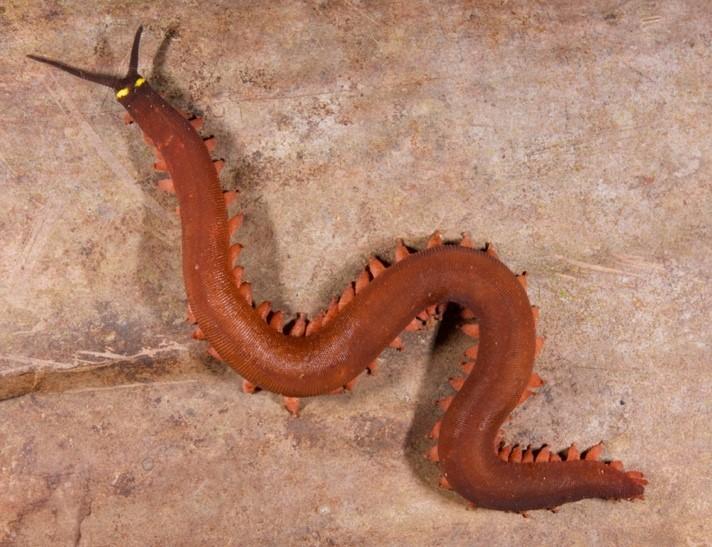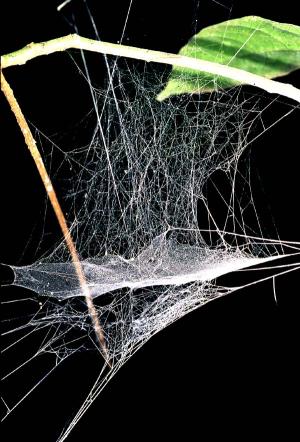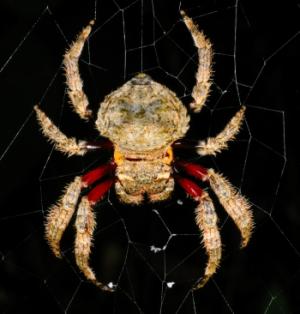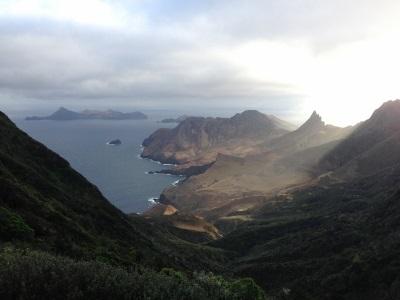The research in the Hormiga laboratory focuses on the systematics and evolutionary biology of spiders, with emphasis on orbweavers and their close relatives (Orbiculariae). We use morphological, molecular and behavioral characters to reconstruct the phylogenetic relationships of our study groups. We tackle questions that span from species level taxonomic problems, addressed using a monographic approach, to intra and interfamilial phylogenetic relationships. We have an active fieldwork program that has taken us around the world in search of our study organisms. Our most recent fieldwork has been carried out in several countries of the Neotropical region, Madagascar and Equatorial Africa, Australia and New Zealand.
Gustavo Hormiga
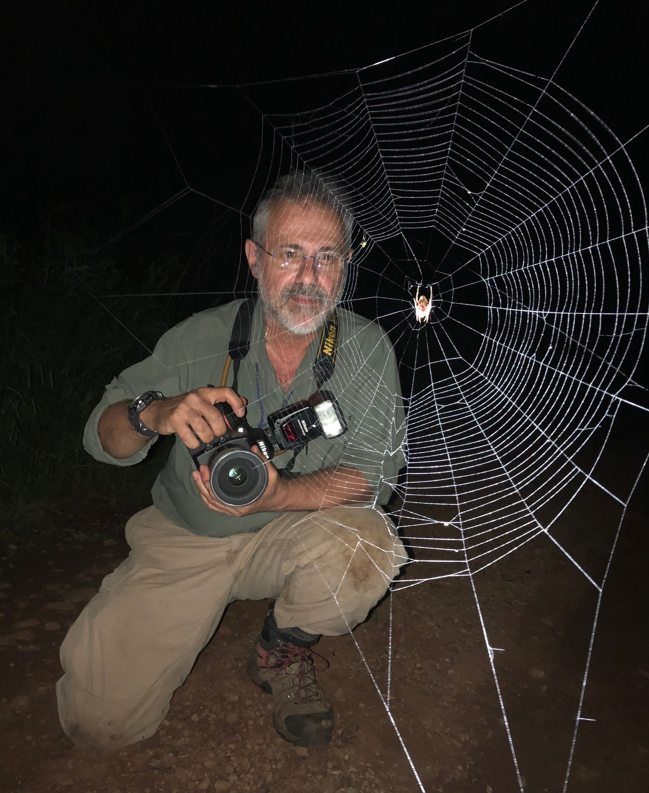
Gustavo Hormiga
Ruth Weintraub Professor of Biology
Systematics, Evolution & Ecology
Contact:
Areas of Expertise
Systematics and evolutionary biology of spiders
New Project
Collaborative Research: PurSUiT: Understanding the Neotropical velvet worms (Onychophora, Peripatidae, Neopatida), a Cretaceous radiation of terrestrial panarthropods
Velvet worms (Onychophora) are fascinating terrestrial invertebrates with a fossil record dating back to the Carboniferous. However, they have remained largely unchanged morphologically during 300 million years, a condition that has warranted to be labelled as “living fossils”. Velvet worms are thus an ideal model to understand how animals colonize different environments and locations through long periods of geological time without the need of much morphological change. But this has been difficult to do because velvet worms are rare, inhabit remote forests, and remain poorly understood, and thus there is a lack of a clear picture of their evolutionary history.
This is a NSF-funded project in the laboratories of Gustavo Hormiga (The George Washington University) and Gonzalo Giribet (Harvard University) which will focus on the least-understood group of Onychophora, the Neotropical Peripatidae, and their radiation around the Caribbean region. We will describe new species, assess their conservation status, with the goal of understanding how this group of placental invertebrates has been able to colonize the Caribbean region through geological time. The research team and several trainees will combine cutting-edge molecular phylogenetic approaches with modern anatomical methods to advance our knowledge of the diversity and evolutionary history of this under-studied group.
We also use comparative phylogenetic methods to study more general questions such as the evolution and diversification of web architecture, the evolution of sexual size dimorphism or the patterns of insular diversification and colonization in oceanic archipelagos.
Current Projects
- National Geographic Society (Committee for Research and Exploration): Colonization and diversification of Laminacauda spiders in the South Pacific archipelago of Juan Fernandez.
(you can read about this research project in GW’s CCAS magazine article) - National Science Foundation, Collaborative Research: The Opiliones of New Zealand: Revisionary synthesis and application of species delimitation for testing biogeographic hypotheses (G. Hormiga, PI at GWU, G. Giribet, PI at Harvard University, S. Boyer PI at Macalester).
- National Science Foundation. Collaborative Research: PurSUiT: Understanding the Neotropical Velvet Worms (Onychophora, Peripatidae, Neopatida), a Cretaceous Radiation of Terrestrial Panarthropods. (G. Hormiga, PI at GWU, G. Giribet, lead PI at Harvard University
Past Projects
- NSF: Phylogeny and diversification of the orb-weaving spiders (G. Hormiga, PI at GW & G. Giribet, PI at Harvard University)
- NSF: ARTS: Collaborative Research: Taxonomy and systematics of selected Neotropical clades of arachnids (G. Hormiga, PI at GW & G. Giribet, PI at Harvard University)
- National Geographic Society (Committee for Research and Exploration)), ‘Playing the tape twice: Parallel colonization and diversification of Laminacauda spiders in the South Pacific and South Atlantic archipelagoes of Juan Fernandez and Tristan da Cuhna’
- NSF: Assembling the Tree of Life: Phylogeny of Spiders
- NSF: PBI Goblin Spider Project
NSF: PEET: Systematics and Monography of Araneoid Spiders
Hormiga, G., Lavery, A. and Arnedo, M., The spider genus Stictonanus Millidge, 1991 in the Juan Fernandez archipelago (Araneae, Linyphiidae): systematics and biogeography. In press. Invertebrate Systematics.
Labarque, F.M., Piacentini, L.N., Pons, J., Hormiga, G., Arnedo, M.A., Ramírez, M.J. 2025. Ray spider rush: Fast-tracking integrative taxonomy in Panama’s cloud forests. European Journal of Taxonomy 1010: 1–145. https://doi.org/10.5852/ejt.2025.1010.3021
Silva Moreira, T., Kulkarni, S., Hormiga, G. 2025. A Total Evidence phylogenetic analysis of the spider family Linyphiidae (Araneae, Araneoidea). Zootaxa Zootaxa 5685(1): 1-78. doi:10.11646/zootaxa.5685.1.1.
Hazzi, N., Wood, H., Hormiga, G. 2025. Repeated habitat shifts and varying dispersal rates between habitats shape ecomorphological assembly of wandering Ctenidae spiders across continents. Journal of Evolutionary Biology 0, 1–15. https://doi.org/10.1093/jeb/voaf074
Giribet, G., Anilkumar, P.A., Goodwin, A., Stewart, R.S., Whyte, D., Watkis, C.A., Hormiga, G. 2025. On the troglobitic velvet worm Speleoperipatus spelaeus Peck, 1975 (Onychophora, Peripatidae): assessing the status of a Critically Endangered Jamaican invertebrate. Subterranean Biology 51: 49–59. https://doi.org/10.3897/subtbiol.51.151034
Burgo, A., Catley, K. Grismado, C. Dupérré, N., Benjamin, S.P., Hormiga, G., Griswold, C.E., Martínez, L., Ramírez, M.J. 2025. Systematics of the color-polymorphic spider genus Cybaeolus, with comments on the phylogeny of the family Hahniidae (Araneae). Zoological Journal of the Linnean Society, Volume 203, Issue 1, January 2025, zlae165. https://doi.org/10.1093/zoolinnean/zlae165
Morris, S.A., Nicolas A. Hazzi, N.A., and Hormiga, G. 2025. Molecular phylogenetics of nursery web spiders (Araneae: Pisauridae). Molecular Phylogenetics and Evolution 203 (108247): 1-13. https://doi.org/10.1016/j.ympev.2024.108247
Hazzi, N., Wood, H., Hormiga, G. 2025. Reassessing the evolutionary relationships of tropical wandering spiders using phylogenomics: A UCE-based phylogeny of Ctenidae (Araneae) with the discovery of a new lycosoid family. Molecular Phylogenetics and Evolution 203(108245): 1-11. https://doi.org/10.1016/j.ympev.2024.108245
Sherwood, D., Henrard, A., Jocqué, R., Fowler, L., Marusik, Y. M., Maddison, W., Harvey, M. S., Hormiga, G., Rheims, C. A., Piacentini, L. N., Peters, M., Stevens, N., Joshua, D., Scipio-O’Dean, C. J., Ellick, G., Wilkins, V., Ashmole, M. & Ashmole, P. 2024. Annotated checklist of the spiders of Saint Helena, with new records, descriptions of unknown sexes, new and restored genera, and two new species (Araneae: Araneomorphae). Arachnology 19(9): 1218-1291. https://doi.org/10.13156/arac.2024.19.9.1218
Hazzi, N. & Hormiga, G. 2024. Systematics, distribution patterns and historical biogeography of the Central America wandering spider genus Kiekie Polotow & Brescovit, 2018 (Araneae: Ctenidae). PeerJ 12(e17242): 1-55. https://doi.org/10.7717/peerj.17242
Hormiga, G., S. Kulkarni, M. Arnedo, D. Dimitrov, G. Giribet, R. J. Kallal & N. Scharff. 2023. Genitalic morphology and phylogenomic placement of the Australian spider Paraplectanoides crassipes Keyserling, 1886 (Araneae, Araneidae) with a discussion on the classification of the family Araneidae. Invertebrate Systematics 37(12), 797–818. https://doi.org/10.1071/IS23050
Kulkarni, S.K., Wood, H. & Hormiga, G. 2023. Advances in the reconstruction of the Spider Tree of Life: a roadmap for spider systematics and comparative studies. Cladistics. https://doi.org/10.1111/cla.12557
Kulkarni, S.K., Wood, H. & Hormiga, G. 2023. Phylogenomics illuminate the evolution of orb webs, respiratory systems and the biogeographic history of the world’s smallest orb-weaving spiders (Araneae, Araneoidea, Symphytognathoids). Molecular Phylogenetics and Evolution, 186. https://doi.org/10.1016/j.ympev.2023.107855
Hormiga, G. & Eberhard, W.G. 2023. Sheet webs of linyphioid spiders (Araneae: Linyphiidae, Pimoidae): the light of diversity hidden under a linguistic basket. Bulletin of the Museum of Comparative Zoology 163 (8): 279-415. https://mczbase.mcz.harvard.edu/specimen_images/publications/Bulletin_163_08.pdf
Liu, J., X. Xu, G. Hormiga, H. Yin. 2023. Two new species of the spider genus Putaoa (Araneae, Linyphiidae) from southern China. Zootaxa 5277(3): 553-564. https://doi.org/10.11646/zootaxa.5277.3.7.
Prada, C.F., Hazzi, N.A., Hormiga, G., Cabarcas, F. and Franco, L.M. 2022. Complete mitochondrial genome of Phoneutria depilata (Araneae, Ctenidae): New Insights into the Phylogeny and Evolution of Spiders. Gene. 2023 Jan; 850:146925. https://doi.org/10.1016/j.gene.2022.146925
Hazzi, N.A. & Hormiga, G. 2022. Molecular phylogeny of the tropical wandering spiders (Araneae, Ctenidae) and the evolution of eye conformation in the RTA clade. Cladistics. https://doi.org/10.1111/cla.12518
Kallal, R.J. & Hormiga, G. 2022. Artiphex nom. nov. (Araneae: Araneidae), a new replacement name for Artifex Kallal & Hormiga, 2018, preoccupied by Artifex Silveira, 2008 (Hymenoptera: Vespidae). Zootaxa, 5175(3), 394-394. https://doi.org/10.11646/zootaxa.5175.3.7
Kallal, R.J. & Hormiga, G. 2022. The family placement of the Asian orb-weaving spider genus Guizygiella Zhu, Kim & Song, 1997 (Araneae: Araneoidea). Zootaxa 5175.1 (2022): 146-150. https://doi.org/10.11646/zootaxa.5175.1.8
Wolff, Jonas O., Kaja Wierucka, Gustavo Paterno, Jonathan A. Coddington, Gustavo Hormiga, Michael B. J. Kelly, Marie E. Herberstein, Martín J. Ramírez. 2022. Stabilized morphological evolution of spiders despite mosaic changes in foraging ecology. Systematic Biology. https://doi.org/10.1093/sysbio/syac023.
Ballesteros, Jesús A., Carlos E. Santibáñez-López, Caitlin M. Baker, Ligia R. Benavides, Tauana J. Cunha, Guilherme Gainett, Andrew Z. Ontano, Emily V.W. Setton, Claudia P. Arango, Efrat Gavish-Regev, Mark S. Harvey, Ward C. Wheeler, Gustavo Hormiga, Gonzalo Giribet, Prashant P. Sharma. 2022. Comprehensive species sampling and sophisticated algorithmic approaches refute the monophyly of Arachnida. Molecular Biology and Evolution, 39(2). https://doi.org/10.1093/molbev/msac021.
Da Silva-Moreira, T. da & Hormiga, G. 2022. Revision and phylogenetics of the Neotropical sheet weaving spider genus Diplothyron Millidge, 1991 (Araneae, Linyphiidae) and systematics of the MPME clade. Invertebrate Systematics 36(9), 781–848. doi:10.1071/IS21047
Lopardo, L., Michalik, P. & Hormiga, G. 2021. Take a deep breath... The evolution of the respiratory system of symphytognathoid spiders (Araneae, Araneoidea). Organisms, Diversity and Evolution 22: 231–263. https://doi.org/10.1007/s13127-021-00524-w
Kulkarni, S.K., & Hormiga, G. 2021. Hooroo mates! Phylogenomic data suggest that the closest relatives of the iconic Tasmanian Cave Spider Hickmania troglodytes are in Australia and New Zealand, not in South America. Invertebrate Systematics 35(8): 850-856. https://doi.org/10.1071/IS21030.
Ballesteros, J.A. & Hormiga, G. 2021. Molecular phylogeny of the orb-weaving spider genus Leucauge and the intergeneric relationships of Leucauginae (Araneae, Tetragnathidae). Invertebrate Systematics 35(8): 922-939. doi:10.1071/IS21029.
Giribet, G., K. Sheridan, C. M. Baker, C.J. Painting, G.I. Holwell, P.J. Sirvid, and G. Hormiga. 2021. A molecular phylogeny of the circum-Antarctic Opiliones family Neopilionidae. Invertebrate Systematics 35 (8827-849 35. https://doi.org/10.1071/IS21029
Hormiga, G., Kulkarni, S., Moreira, T. da Silva & Dimitrov, D. 2021. Molecular phylogeny of pimoid spiders and the limits of Linyphiidae, with a reassessment of male palpal homologies (Araneae, Pimoidae). Zootaxa 5026(1): 71-101. https://doi.org/10.11646/zootaxa.5026.1.3
Liu, J. X., Xu, X., Hormiga, G. & Yin, H. Q. 2021. New species of the pirate spider genus Mimetus Hentz, 1832 from China with a cladistic hypothesis on their phylogenetic placement (Araneae, Mimetidae). Zootaxa 5020(1): 1-30. https://doi.org/10.11646/zootaxa.5020.1.1
Jäger, Peter, Miquel A. Arnedo, Guilherme H. F. Azevedo, Barbara Baehr, Alexandre B. Bonaldo, Charles Haddad, Danilo Harms, Gustavo Hormiga, Facundo M. Labarque, Christoph Muster, Martín J. Ramírez. 2021. Twenty years, eight legs, one concept: describing spider biodiversity in Zootaxa (Arachnida: Araneae). Zootaxa a 4979 (1): 131–146. https://www.mapress.com/j/zt/
Hazzi N.A., Hormiga G. 2021. Corrigenda: Morphological and molecular evidence support the taxonomic separation of the medically important Neotropical spiders Phoneutria depilata (Strand, 1909) and P. boliviensis (F.O. Pickard-Cambridge, 1897) (Araneae, Ctenidae). ZooKeys 1022: 13–50. https://doi.org/10.3897/zookeys.1022.60571. Zookeys 1033: 203–205. https://doi.org/10.3897/zookeys.1033.65850
Hazzi N.A., Hormiga G. 2021. Morphological and molecular evidence support the taxonomic separation of the medically important Neotropical spiders Phoneutria depilata (Strand, 1909) and P. boliviensis (F.O. Pickard-Cambridge, 1897) (Araneae, Ctenidae). ZooKeys 1022: 13-50. https://doi.org/10.3897/zookeys.1022.60571
Da Silva Moreira, T. & Hormiga, G. 2021. Phylogenetic analysis and taxonomic revision of the Neotropical spider genera Jalapyphantes Gertsch & Davis, 1946 and Selenyphantes Gertsch & Davis, 1946 and phylogenetic placement of the Pocobletus clade (Araneae, Linyphiidae). Zoological Journal of the Linnean Society.
Dimitrov, D. & Hormiga, G. 2021. Spider diversification through space and time. Annual Review of Entomology 66 (2021): 225-241. https://doi.org/10.1146/annurev-ento-061520-083414
Kulkarni, S.K., Kallal, R.J., Wood, H., Dimitrov, D., Giribet, G., & Hormiga, G. 2021. Interrogating genomic-scale data to resolve recalcitrant nodes in the Spider Tree of Life. Molecular Biology and Evolution 38 (3): 891–903. https://doi.org/10.1093/molbev/msaa251
Kallal, R.J., Kulkarni, S.K., Dimitrov, Benavides, L.R., Arnedo, M.A., Giribet, G., & Hormiga, G. 2021. Converging on the orb: denser taxon sampling elucidates spider phylogeny and new analytical methods support repeated evolution of the orb web. Cladistics. https://doi.org/10.1111/cla.12439
Arnedo, M.A. and Hormiga, G. 2021. Repeated colonization, adaptive radiation and convergent evolution in the sheet-weaving spiders (Linyphiidae) of the south Pacific Archipelago of Juan Fernandez. Cladistics 37: 317–342. https://doi.org/10.1111/cla.12437
Kallal, R.J. & Hormiga, G. 2020. Phylogenetic placement of the stone-nest orb weaving spider Nemoscolus Simon, 1895 (Araneae, Araneidae) and the description of a new Australian species. Invertebrate Systematics 34(8): 893-905. https://doi.org/10.1071/IS20035
Dimitrov, D. & Hormiga, G. In press. Spider diversification through space and time. Annual Review of Entomology 66 (2021). https://doi.org/10.1146/annurev-ento-061520-083414
Platnick, N.I. (editor), Hormiga, G., Jäger, P., Jocqué, R., Ramírez, M.J. & Raven, R.J. 2020. Spiders of the World: A Natural History. Princeton University Press. 240 pp. ISBN 9780691188850.
Hormiga, G. & Scharff, N. 2020. The malkarid spiders of New Zealand (Araneae, Malkaridae). Invertebrate Systematics 34, 345-405. https://doi.org/10.1071/IS19073
Benavides, L.R., & Hormiga, G. 2020. A morphological and molecular phylogenetic analysis of pirate spiders (Araneae, Mimetidae): evolutionary relationships, taxonomy, and character evolution. Invertebrate Systematics 34, 144–191. https://doi.org/10.1071/IS19032.
Cabra, J. & Hormiga, G. 2020. Exploring the impact of morphology, multiple sequence alignment approach and choice of optimality criteria in phylogenetic inference: a case study with the Neotropical orb-weaving spider genus Wagneriana (Araneae: Araneidae). Zoological Journal of the Linnean Society 188(4): 976-1151. doi:10.1093/zoolinnean/zlz088
Álvarez-Padilla, F., Kallal, R.J., & Hormiga, G. 2020. Taxonomy and Phylogenetics of Nanometinae and other Australasian Orb-Weaving Spiders (Araneae: Tetragnathidae). Bulletin of the American Museum of Natural History 438: 1-107. http://digitallibrary.amnh.org/handle/2246/7008
Kulkarni, S., Wood, H., Lloyd, M. & Hormiga, G. 2020. Spider‐specific probe set for ultraconserved elements offers new perspectives on the evolutionary history of spiders (Arachnida, Araneae). Molecular Ecology Resources 20: 185-203. https://doi.org/10.1111/1755-0998.13099
Kallal, R.J., Dimitrov, D., Arnedo, M.A., Giribet, G. & Hormiga, G. 2020. Monophyly, Taxon Sampling, and the Nature of Ranks in the Classification of Orb-weaving Spiders (Araneae: Araneoidea). Systematic Biology 69: 401-411. https://doi.org/10.1093/sysbio/syz043
Kallal, R.J., Moore, A.J., & Hormiga, G. 2019. The shape of weaver: investigating shape disparity in orb-weaving spiders (Araneae, Araneidae) using geometric morphometrics. Evolutionary Biology 46:317-331. https://doi.org/10.1007/s11692-019-09482-w
Michalik, P., Kallal, R.J., Dederichs, T.M., Labarque, F., Hormiga, G., Giribet, G., & Ramírez, M.J. 2019. Phylogenomics and genital morphology of cave raptor spiders (Araneae, Trogloraptoridae) reveal an independent acquisition of a flow-through female genital system. Journal of Zoological Systematics and Evolutionary Research 57: 737-747. https://doi.org/10.1111/jzs.12315
Benavides, L.R., Hormiga, G. & Giribet, G. 2019. Phylogeny, evolution and systematic revision of the mite-harvestmen family Neogoveidae (Opiliones, Cyphophthalmi). Invertebrate Systematics 33(1):101-180. https://doi.org/10.1071/IS18018
Kallal, R.J. & Hormiga G. 2019. Evolution of the male palp morphology of the orb-weaver hunting spider Chorizopes (Araneae, Araneidae) revisited on a new phylogeny of Araneidae, and description of a third species from Madagascar. Invertebrate Systematics 33(3): 473-487. https://doi.org/10.1071/IS18061
Kallal RJ & Hormiga G. 2018. Systematics, phylogeny, and biogeography of the Australasian leaf-curling orb-weaving spiders (Araneae: Araneidae: Zygiellinae), with a comparative analysis of retreat evolution. Zoological Journal of the Linnean Society. DOI:10.1093/zoolinnean/zly014
Fernández, R., Kallal, R.J., Dimitrov, D., Ballesteros, J.A., Arnedo, M.A., Giribet, G. and Hormiga, G., 2018. Phylogenomics, Diversification Dynamics, and Comparative Transcriptomics across the Spider Tree of Life. Current Biology, 28(9):1489-1497. DOI: https://doi.org/10.1016/j.cub.2018.03.064
Kallal, R.J., Fernández, R., Giribet, G. and Hormiga, G., 2018. A phylotranscriptomic backbone of the orb-weaving spider family Araneidae (Arachnida, Araneae) supported by multiple methodological approaches. Molecular phylogenetics and evolution. 126: 129-140.
Kallal, R.J. and Hormiga, G., 2018. An expanded molecular phylogeny of metaine spiders (Araneae, Tetragnathidae) with description of new taxa from Taiwan and the Philippines. Invertebrate Systematics, 32(2): 400-422.
Huang, D., Hormiga, G., Cai, C., Su, Y., Yin, Z., Xia, F. and Giribet, G. 2018. Origin of spiders and their spinning organs illuminated by mid-Cretaceous amber fossils. Nature Ecology & Evolution, 2(4):623.
Ballesteros, J.A. and Hormiga, G. 2018. Species delimitation of the North American orchard-spider Leucauge venusta (Walckenaer, 1841)(Araneae, Tetragnathidae). Molecular phylogenetics and evolution, 121: 183-197.
Hormiga, G. and Dimitrov, D. 2017. The discovery of the spider genus Putaoa (Araneae, Pimoidae) in Taiwan with the description of a new species, including its web architecture. Zootaxa, 4341(1): 97-104.
Hormiga, G. 2017. The discovery of the orb-weaving spider genus Pinkfloydia (Araneae, Tetragnathidae) in eastern Australia with description of a new species from New South Wales and comments on the phylogeny of Nanometinae. Zootaxa, 4311(4): 480-490.
Wheeler, W.C., Coddington, J.A., Crowley, L.M., Dimitrov, D., Goloboff, P.A., Griswold, C.E., Hormiga, G., Prendini, L., Ramírez, M.J., Sierwald, P., Almeida-Silva, L., Álvarez-Padilla F., Arnedo M.A., Benavides Silva, L.R., Benjamin, S.P., Bond, J.E., Grismado, C.J., Hasan, E., Hedin, M., Izquierdo, M.A., Labarque, F.M., Ledford, J., Lopardo, L., Maddison, W.P., Miller, J.A., Piacentini, L.N., Platnick, N.I., Polotow, D., Silva-Dávila, D., Scharff, N., Szűts, T., Ubick, D., Vink, C.J., Wood, H.M., and Zhang, J.X. 2016. The spider tree of life: phylogeny of Araneae based on target-gene analyses from an extensive taxon sampling. Cladistics 2016 (online version), 1–43,
Benavides, L. R., Giribet, G., and Hormiga, G. 2017. Molecular phylogenetic analysis of pirate spiders (Araneae, Mimetidae) with the first description of maternal care behavior in the family and the description of a new African genus. Cladistics 33.4 (2017): 375-405.
Mammola, S., Hormiga, G. and Isaia, M. 2017. Species conservation profile of the stenoendemic cave spider Pimoa delphinica (Araneae, Pimoidae) from the Varaita valley (NW-Italy). Biodiversity Data Journal, 5, p.e11509.
Hormiga, G. and S. Lew. 2017. Pimoidae. In: Darrell Ubick, Pierre Paquin, & Paula E. Cushing, (eds.) Spiders of North America: an identification manual.
Levi, H.W. and G. Hormiga. 2017. Tetragnathidae. In: Darrell Ubick, Pierre Paquin, & Paula E. Cushing, (eds.) Spiders of North America: an identification manual.
Dimitrov D., L.R. Benavides, M.A. Arnedo, G. Giribet, C.E. Griswold, N. Scharff, and G. Hormiga. 2017. Rounding up the usual suspects: a standard target-gene approach for resolving the interfamilial phylogenetic relationships of ecribellate orb-weaving spiders with a new family-rank classification (Araneae, Araneoidea). Cladistics 33: 221-250. DOI: 10.1111/cla.12165
Giribet, G. And G. Hormiga. 2016. Chapter 24. Phylum Arthropoda: The Chelicerata. In: Brusca, R. (Ed.) The Invertebrates, 3rd Edition.
Mammola S., Hormiga G., Arnedo M.A., and Isaia M. 2016. Unexpected diversity in the relictual European spiders of the genus Pimoa (Araneae, Pimoidae). Invertebrate Systematics 30(6): 566 587.
Ballesteros-Chavez, J. and Hormiga, G.. 2016. A new orthology assessment method for phylogenomic data: Unrooted Phylogenetic Orthology. Mol. Bio. Evol. 33: 2117-2134. doi: 10.1093/molbev/msw069.
Giribet, G., Hormiga, G. and Edgecombe, G.D. 2016. The meaning of categorical ranks in evolutionary biology. Organisms Diversity & Evolution, 16(3): 427-430. 10.1007/s13127-016-0263-9
Kallal, R.J and G. Hormiga. 2016. Redescription of the Jamaican orb-weaving spider Chrysometa pecki Levi, 1986 (Araneae, Tetragnathidae), including the first description of the male. Zootaxa 4066 (1): 95–100.
Benavides, L. R. & G. Hormiga. 2016. Taxonomic revision of the Neotropical pirate spiders of the genus Gelanor Thorell, 1869 (Araneae, Mimetidae) with the description of five new species. Zootaxa 4064:1-72.
Wang, F., Ballesteros, J. A., Hormiga, G., Chesters, D., Zhan, Y., Sun, N., Zhu, C., Chen, W. & Tu, L. 2015. Resolving the phylogeny of a speciose spider group, the family Linyphiidae (Araneae). Molecular phylogenetics and evolution 91, 135-149. doi:10.1016/j.ympev.2015.05.005
Moreira TDS, Hormiga G. 2015. Redescription and phylogenetic placement of the Hispaniolan spider genus Lomaita, Bryant 1948 (Araneae, Linyphiidae). Zootaxa 3920 (2): 249–264
Sharma, P. P., Kaluziak, S., Pérez-Porro, A. R., González, V. L., Hormiga, G., Wheeler, W. C. & Giribet, G. 2014. Phylogenomic interrogation of Chelicerata reveals systemic conflicts in phylogenetic signal. Molecular Biology and Evolution 31 (11): 2963-2984. doi:10.1093/molbev/msu235
Lopardo, L., and G. Hormiga. 2015. Out of the twilight zone: Phylogeny and evolutionary morphology of the orb-weaving spider family Mysmenidae, with focus on spinneret spigot morphology in symphytognathoids (Araneae, Araneoidea). Zoological Journal of the
Linnaean Society 173, 527–786.
Fernández, R., G. Hormiga and G. Giribet. 2014. Phylogenomic analysis of spiders reveals nonmonophyly of orb weavers. Current Biology 24(15): 1772-1777. Published online July 17, 2014.
Hormiga, G. and J. Ballesteros Chávez. 2014. Chapter 26. Panarthropods: Arthropods and their closest relatives. In The Tree of Life (Edited by P. Vargas and R. Zardoya), pp. 305-314. Sinauer Associates.
Hormiga, G. and S. Lew. 2014. A new American species of the spider genus Pimoa (Araneae, Pimoidae). Zootaxa 3827 (1): 95–100.
Hormiga, G. and N. Scharff. 2014. The strange case of Laetesia raveni n. sp., a green linyphiid spider from Eastern Australia with a preference for thorny plants (Araneae, Linyphiidae). Zootaxa 3811 (1): 83–94.
Hormiga, G. and J. Ballesteros Chavez. 2014. Chapter 26. Panarthropoda: Arthropods and their closest relatives. The Tree of Life, R. Zardoya and P. Vargas, Editors, pp. 305-314.
Cabra-García, J., G. Hormiga and A.D. Brescovit. 2014. Female genital morphology in the secondarily haplogyne spider genus Glenognatha Simon, 1887 (Araneae, Tetragnathidae), with comments on its phylogenetic significance. Journal of Morphology 275(9): 1027-1040. DOI: 10.1002/jmor.20280
Scharff, N. and G. Hormiga. 2013. On the Australian linyphiid spider Alaxchelicera ordinaria Butler, 1932 (Araneae). Zootaxa 3750 (2): 193–196.
Hormiga, G. and C.E. Griswold. 2014. Systematics, Phylogeny and Evolution of Orb-weaving Spiders. Annual Review of Entomology 59: 487-512.
Andriamalala, D. and G. Hormiga. 2013. Systematics of the goblin spider genus Opopaea (Araneae, Oonopidae) in Madagascar. Bulletin of the American Museum of Natural History 380: 1-156.
Gavish-Regev, E., G. Hormiga and N. Scharff. 2013. Pedipalp sclerite homologies and phylogenetic placement of the spider genus Stemonyphantes (Linyphiidae, Araneae) and its implications for linyphiid phylogeny. Invertebrate Systematics27(1): 38-52.
Murienne, J., Benavides, L. R., Prendini, L., Hormiga, G., Giribet, G. 2012. Forest refugia in Western and Central Africa as 'museums' of Mesozoic biodiversity. Biology Letters 9: 20120932.
Scharff, N. and G. Hormiga. 2012. First evidence of aggressive chemical mimicry in the Malagasy orb weaving spider Exechocentrus lancearius (Arachnida: Araneae: Araneidae) and description of a second species. Insect Systematics & Evolution 70(2): 107-118.
Dimitrov, D., L. Lopardo, G. Giribet, M. A. Arnedo, F. Álvarez-Padilla and G. Hormiga. 2012. Tangled in a sparse spider web: single origin of orb weavers and their spinning work unravelled by denser taxonomic sampling. Proceedings of the Royal Society B. 279 (1732):1341-1350. (doi:10.1098/rspb.2011.2011 )
Lopardo, L., G. Giribet and G. Hormiga. 2011. Morphology to the rescue: Molecular data and the signal of morphological characters in combined phylogenetic analyses—A case study from mysmenid spiders (Araneae, Mysmenidae), with comments on the evolution of web architecture. Cladistics 27, 278-330 (cover article). (doi:10.1111/j.1096-0031.2010.00332.x)
Dimitrov, D. and G. Hormiga. 2011. An extraordinary new genus of spiders from Western Australia with an expanded hypothesis on the phylogeny of Tetragnathidae (Araneae). Zoological Journal of the Linnean Society, 161: 735-768.
Álvarez-Padilla, F. and G. Hormiga. 2011. Morphological and phylogenetic atlas of the orbweaving spider family Tetragnathidae (Araneae: Araneoidea). Zoological Journal of the Linnean Society 162(4): 713-880.
Tu, L., and G. Hormiga. 2011. Phylogenetic analysis and revision of the linyphiid spider genus Solenysa (Araneae: Linyphiidae: Erigoninae). Zoological Journal of the Linnean Society 161, 484–530.
Michalik, P. and G. Hormiga. 2010. Ultrastructure of the spermatozoa in the spider genus Pimoa – new evidence for the monophyly of Pimoidae plus Linyphiidae (Arachnida: Araneae). American Museum Novitates 3682: 1-17.
Dimitrov D., Hormiga G. 2010. Mr. Darwin’s mysterious spider: On the type species of the genus Leucauge White, 1841 (Tetragnathidae, Araneae). ZOOTAXA2396:19–36.
Tu, L., and G. Hormiga. 2010. The female genitalic morphology of “micronetine” spiders (Araneae, Linyphiidae). Genetica (DOI 10.1007/s10709-009-9368-9).
Benjamin, S., and G. Hormiga. 2009. Phylogenetic placement of the enigmatic genus Labullinyphia Van Helsdingen, 1985, with redescription of Labullinyphia tersa (Simon, 1894) from Sri Lanka (Araneae: Linyphiidae). Contributions to Natural History 12: 161-181.
Dimitrov, D., Benjamin, S., and G. Hormiga. 2009. A revised phylogenetic analysis for the genus Clitaetra Simon, 1889 (Araneoidea, Nephilidae) with the first description of the male of the Sri Lankan species Clitaetra thisbe Simon, 1903. Bulletin of the Museum of Comparative Zoology 159(6): 301-323. (doi:10.3099/0027-4100-159.6.301).
Arnedo, M.A., G. Hormiga, and N. Scharff. 2009. Higher level phylogenetics of linyphiid spiders (Araneae, Linyphiidae) based on morphological and molecular evidence. Cladistics 25: 231-262.
Álvarez-Padilla F., Dimitrov D., Giribet G., Hormiga G. 2009. Phylogenetic relationships of the spider family Tetragnathidae (Araneae, Araneoidea) based on morphological and DNA sequence data. Cladistics 25:109-146. (doi:10.1111/j.1096-0031.2008.00242.x)
Tu, L., and G. Hormiga. 2009. The female genitalic morphology of “micronetine” spiders (Araneae, Linyphiidae). Genetica (DOI 10.1007/s10709-009-9368-9).
Arnedo, M.A., G. Hormiga, and N. Scharff. 2009. Higher level phylogenetics of linyphiid spiders (Araneae, Linyphiidae) based on morphological and molecular evidence. Cladistics 25: 231-262.
Álvarez-Padilla F., Dimitrov D., Giribet G., Hormiga G. 2009. Phylogenetic relationships of the spider family Tetragnathidae (Araneae, Araneoidea) based on morphological and DNA sequence data. Cladistics 25:109-146. (doi: 10.1111/j.1096-0031.2008.00242.x)
Santos, A.J., M. O. Gonzaga, and G. Hormiga. 2009. Notes on two problematic eastern Asian species of the spider genus Oecobius (Araneae: Oecobiidae, Linyphiidae). Journal of Arachnology 37:101-102.
Coddington, J.A., I. Agnarsson, J. A. Miller, M. Kuntner and G. Hormiga. 2009. Undersampling bias: the null hypothesis for singleton species in tropical arthropod surveys. Journal of Animal Ecology 78:573–584.
Dimitrov D., Hormiga, G. 2009. Revision and cladistic analysis of the orbweaving spider genus Cyrtognatha Keyserling, 1881 (Araneae, Tetragnathidae). Bulletin of the American Museum of Natural History 317:1-140. PDF available via the AMNH research library (very large file).
Hormiga, G. 2008 . On the spider genus Weintrauboa (Araneae, Pimoidae), with a description of a new species from China and comments on its phylogenetic relationships. ZOOTAXA 1814: 1-20.
Hormiga, G. and L. Tu. 2008. On Putaoa, a new genus of the spider family Pimoidae (Araneae) from southern China, with a cladistic test of its monophyly and phylogenetic placement. ZOOTAXA 1792: 1-21.
Kuntner, M., J. Coddington and G. Hormiga. 2008. Phylogeny of extant nephilid orb-weaving spiders (Araneae, Nephilidae): testing morphological and ethological homologies. Cladistics 24: 147-217.
Benjamin PS., Dimitrov D., Gillespie RG., Hormiga, G. 2008. Family ties: molecular phylogeny of crab spiders (Araneae: Thomisidae). Cladistics 24(5): 708-722. (doi: 10.1111/j.1096-0031.2008.00202.x)
Lopardo, L. and G. Hormiga. 2008. Phylogenetic placement of the Tasmanian spider Acrobleps hygrophilus (Araneae, Anapidae) with comments on the evolution of the capture web in Araneoidea. Cladistics 24: 1-33.
Dimitrov D., Álvarez-Padilla F., Hormiga G. 2008. Until dirt do us apart: on the unremarkable palp morphology of the spider Sternospina concretipalpis Schmidt& Krause, 1993, with comments on the genus Prionolaema Simon, 1894 (Araneae, Tetragnathidae). ZOOTAXA, 1698: 49-56.
Alvarez-Padilla, F. and G. Hormiga. 2008. A protocol for digesting internal soft tissues and mounting spiders for scanning electron microscopy. Journal of Arachnology 35: 538-542.
Dimitrov D., Alvarez-Padilla F., Hormiga,G. 2007. The female genitalic morphology of the orb weaving spider genus Agriognatha (Araneae, Tetraganthidae). Journal of Morphology 268(9): 758-770.
Hormiga, G., F. Alvarez-Padilla and S.P. Benjamin. 2007. First records of extant Hispaniolan spiders of the families Mysmenidae, Symphytognathidae and Ochyroceratidae (Araneae), including a new species of Ochyrocera. American Museum Novitates 3577: 1-21.
Lopardo, L. and G. Hormiga. 2007. On the spider genus Cepheia Simon 1894(Araneae, Synaphridae). American Museum Novitates 3575: 1-18.
Ramírez, M.J., J.A. Coddington, W.P. Maddison, P.E. Midford, L. Prendini, J. Miller, C.E. Griswold, G. Hormiga, P. Sierwald, N. Scharff, S.P. Benjamin, and W.C. Wheeler. 2007. Linking of Digital Images to Phylogenetic Data Matrices Using a Morphological Ontology. Systematic Biology, 56 (2): 283-294.
Lopardo, L., G. Hormiga and A. Melic. 2007. Spinneret spigot morphology in synaphrid spiders (Araneae, Synaphridae), with comments on the systematics of the family and description of a new species of Synaphris Simon 1894 from Spain. American Museum Novitates, 3556: 1-26.
Hormiga, G. and S. Lew. 2005. Chapter 48: Pimoidae. In: Darrell Ubick, Pierre Paquin, Paula E. Cushing, & Vince Roth (eds.) Spiders of North America: an identification manual (pp. 197-198). Download PDF
Hormiga, G., D.J. Buckle and N. Scharff. 2005. Nanoa, an enigmatic new genus of pimoid spiders from western North America (Pimoidae, Araneae). Zoological Journal of the Linnean Society 145:249-262. Download PDF
Hormiga, G. and N. Scharff. 2005. Monophyly and phylogenetic placement of the spider genus Labulla Simon, 1884 (Araneae, Linyphiidae) and description of the new genus Pecado. Zoological Journal of the Linnean Society 143:359-404.Download PDF
Miller, J.A. and G. Hormiga. 2004. Clade Stability and the Addition of Data - A Case Study from Erigonine Spiders (Araneae: Linyphiidae, Erigoninae). Cladistics 20: 385-442. (cover article) Download PDF Download Software (Pest 3.0)
Hormiga, G. 2003. Weintrauboa, a new genus of pimoid spiders from Japan and adjacent islands, with comments on the monophyly and diagnosis of the family Pimoidae and the genus Pimoa (Araneoidea, Araneae). Zoological Journal of the Linnean Society, 139: 261-281. Download PDF
Hormiga, G., Arnedo, M. Gillespie, R. G. 2003. Speciation on a Conveyor Belt: Sequen-tial Colonization of the Hawaiian Islands by Orsonwelles Spiders (Araneae, Linyphiidae). Systematic Biology 52(1): 70-88 (cover article). Download PDF
Hormiga, G. 2002. Orsonwelles, a new genus of giant linyphiid spiders (Araneae) from the Hawaiian Islands. Invertebrate Systematics 16:369-448 (cover article). Download PDF
Hormiga, G., N. Scharff, and J. Coddington. 2000. The Phylogenetic Basis of Sexual Size Dimorphism in Orb-Weaving Spiders (Araneae, Orbiculariae). Systematic Biology 49(3):435-462. Download PDF
Hormiga, G. 2000a. Higher level phylogenetics of erigonine spiders (Araneae, Linyphiidae, Erigoninae). Smithsonian Contributions to Zoology, 609:1-160.
Griswold, C., J. Coddington, G. Hormiga, and N. Scharff. 1998. Phylogeny of the orb web building spiders (Araneomorphae, Orbiculariae). Zoological Journal of the Linnean Society, 123:1-99. Download PDF
Coddington, J.A., G. Hormiga, and N. Scharff. 1997. Giant Female or Dwarf Male Spiders? Nature, 385:687-688. Download PDF
Hormiga, G., W.G. Eberhard, and J.A. Coddington. 1995. Web construction behavior in Australian Phonognatha and the phylogeny of nephiline and tetragnathid spiders (Araneae, Tetragnathidae). Australian Journal of Zoology, 43:313-364. Download PDF
Hormiga, G. 1994a. A revision and cladistic analysis of the spider family Pimoidae (Araneae: Araneoidea). Smithsonian Contributions to Zoology, 549:1-105.
Hormiga, G. 1994b. Cladistics and the comparative morphology of linyphiid spiders and their relatives (Araneae, Araneoidea, Linyphiidae). Zoological Journal of the Linnean Society, 111:1-71. Download PDF
Hormiga, G. 1993a. Implications of the phylogeny of Pimoidae for the systematics of linyphiid spiders (Araneae, Araneoidea, Linyphiidae). Memoirs of the Queensland Museum, 33(2):533-542.
For reprint requests, please send an email to hormiga![]() gwu [dot] edu (hormiga[at]gwu[dot]edu)
gwu [dot] edu (hormiga[at]gwu[dot]edu)
B.Sc., Universidad de Barcelona, 1985
M.S., Ph.D., University of Maryland at College Park, 1992, 1995
BISC 6210 - Phylogenetic Systematics (Fall)
BISC 2216 - Scanning Electron Microscopy Lab (Fall)
BISC 6207 - Current Topics in Systematic Biology
- Systematics and Monography of Araneoid Spiders
- LinyGen: Linyphioid Genera of the World (Pimoidae and Linyphiidae), an Illustrated Catalog
- International Society of Arachnology
- American Arachnological Society
- Arachnology Home Page
- Willi Hennig Society
- Systematic Biology (GW)
- Zoological Record
- Nomenclator Zoologicus
- PEET program


